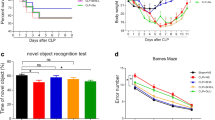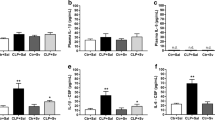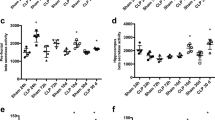Abstract
Sepsis survivors frequently develop late cognitive impairment. Because little is known on the mechanisms of post-septic memory deficits, there are no current effective approaches to prevent or treat such symptoms. Here, we subjected mice to severe sepsis induced by cecal ligation and puncture (CLP) and evaluated the sepsis-surviving animals in the open field, novel object recognition (NOR), and step-down inhibitory avoidance (IA) task at different times after surgery. Post-septic mice (30 days post-surgery) failed in the NOR and IA tests but exhibited normal performance when re-evaluated 45 days after surgery. Cognitive impairment in post-septic mice was accompanied by reduced hippocampal levels of proteins involved in synaptic plasticity, including synaptophysin, cAMP response element-binding protein (CREB), CREB phosphorylated at serine residue 133 (CREBpSer133), and GluA1 phosphorylated at serine residue 845 (GluA1pSer845). Expression of tumor necrosis factor α (TNF-α) was increased and brain insulin signaling was disrupted, as indicated by increased hippocampal IRS-1 phosphorylation at serine 636 (IRS-1pSer636) and decreased phosphorylation of IRS-1 at tyrosine 465 (IRS-1pTyr465), in the hippocampus 30 days after CLP. Phosphorylation of Akt at serine 473 (AktpSer473) and of GSK3 at serine 9 (GSK3βpSer9) were also decreased in hippocampi of post-septic animals, further indicating that brain insulin signaling is disrupted by sepsis. We then treated post-septic mice with liraglutide, a GLP-1 receptor agonist with insulinotropic activity, or TDZD-8, a GSK3β inhibitor, which rescued NOR memory. In conclusion, these results establish that hippocampal inflammation and disrupted insulin signaling are induced by sepsis and are linked to late memory impairment in sepsis survivors.




Similar content being viewed by others
References
Gofton TE, Young GB (2012) Sepsis-associated encephalopathy. Nat Rev Neurol 8(10):557–566. doi:10.1038/nrneurol.2012.183
Lamar CD, Hurley RA, Taber KH (2011) Sepsis-associated encephalopathy: review of the neuropsychiatric manifestations and cognitive outcome. The Journal of neuropsychiatry and clinical neurosciences 23(3):237–241. doi:10.1176/appi.neuropsych.23.3.237
Widmann CN, Heneka MT (2014) Long-term cerebral consequences of sepsis. The Lancet Neurology 13(6):630–636. doi:10.1016/S1474-4422(14)70017-1
Iwashyna TJ, Ely EW, Smith DM, Langa KM (2010) Long-term cognitive impairment and functional disability among survivors of severe sepsis. JAMA : the journal of the American Medical Association 304(16):1787–1794. doi:10.1001/jama.2010.1553
Pandharipande PP, Girard TD, Jackson JC, Morandi A, Thompson JL, Pun BT, Brummel NE, Hughes CG et al (2013) Long-term cognitive impairment after critical illness. N Engl J Med 369(14):1306–1316. doi:10.1056/NEJMoa1301372
Gunther ML, Morandi A, Krauskopf E, Pandharipande P, Girard TD, Jackson JC, Thompson J, Shintani AK, Geevarghese S, Miller RR, 3rd, Canonico A, Merkle K, Cannistraci CJ, Rogers BP, Gatenby JC, Heckers S, Gore JC, Hopkins RO, Ely EW, Visions Investigation VISNS (2012) The association between brain volumes, delirium duration, and cognitive outcomes in intensive care unit survivors: the VISIONS cohort magnetic resonance imaging study*. Critical care medicine 40 (7):2022–2032. doi:10.1097/CCM.0b013e318250acc0
Semmler A, Widmann CN, Okulla T, Urbach H, Kaiser M, Widman G, Mormann F, Weide J et al (2013) Persistent cognitive impairment, hippocampal atrophy and EEG changes in sepsis survivors. J Neurol Neurosurg Psychiatry 84(1):62–69. doi:10.1136/jnnp-2012-302883
Sharshar T, Bozza F, Chretien F (2014) Neuropathological processes in sepsis. The Lancet Neurology 13(6):534–536. doi:10.1016/S1474-4422(14)70064-X
Bomfim TR, Forny-Germano L, Sathler LB, Brito-Moreira J, Houzel JC, Decker H, Silverman MA, Kazi H et al (2012) An anti-diabetes agent protects the mouse brain from defective insulin signaling caused by Alzheimer’s disease- associated abeta oligomers. J Clin Invest 122(4):1339–1353. doi:10.1172/JCI57256
De Felice FG (2013) Connecting type 2 diabetes to Alzheimer’s disease. Expert Rev Neurother 13(12):1297–1299. doi:10.1586/14737175.2013.864824
De Felice FG (2013) Alzheimer’s disease and insulin resistance: translating basic science into clinical applications. J Clin Invest 123(2):531–539. doi:10.1172/JCI64595
de la Monte SM (2009) Insulin resistance and Alzheimer’s disease. BMB Rep 42(8):475–481
Lourenco MV, Clarke JR, Frozza RL, Bomfim TR, Forny-Germano L, Batista AF, Sathler LB, Brito-Moreira J et al (2013) TNF-alpha mediates PKR-dependent memory impairment and brain IRS-1 inhibition induced by Alzheimer’s beta-amyloid oligomers in mice and monkeys. Cell Metab 18(6):831–843. doi:10.1016/j.cmet.2013.11.002
Talbot K, Wang HY, Kazi H, Han LY, Bakshi KP, Stucky A, Fuino RL, Kawaguchi KR et al (2012) Demonstrated brain insulin resistance in Alzheimer’s disease patients is associated with IGF-1 resistance, IRS-1 dysregulation, and cognitive decline. J Clin Invest 122(4):1316–1338. doi:10.1172/JCI59903
Yarchoan M, Toledo JB, Lee EB, Arvanitakis Z, Kazi H, Han LY, Louneva N, Lee VM et al (2014) Abnormal serine phosphorylation of insulin receptor substrate 1 is associated with tau pathology in Alzheimer’s disease and tauopathies. Acta Neuropathol 128(5):679–689. doi:10.1007/s00401-014-1328-5
van den Berghe G, Wouters P, Weekers F, Verwaest C, Bruyninckx F, Schetz M, Vlasselaers D, Ferdinande P et al (2001) Intensive insulin therapy in critically ill patients. N Engl J Med 345(19):1359–1367. doi:10.1056/NEJMoa011300
Clarke JR, Lyra ESNM, Figueiredo CP, Frozza RL, Ledo JH, Beckman D, Katashima CK, Razolli D et al (2015) Alzheimer-associated a beta oligomers impact the central nervous system to induce peripheral metabolic deregulation. EMBO molecular medicine 7(2):190–210. doi:10.15252/emmm.201404183
Barichello T, Martins MR, Reinke A, Feier G, Ritter C, Quevedo J, Dal-Pizzol F (2005) Cognitive impairment in sepsis survivors from cecal ligation and perforation. Crit Care Med 33(1):221–223 discussion 262-223
Impey S, Smith DM, Obrietan K, Donahue R, Wade C, Storm DR (1998) Stimulation of cAMP response element (CRE)-mediated transcription during contextual learning. Nat Neurosci 1(7):595–601. doi:10.1038/2830
Huganir RL, Nicoll RA (2013) AMPARs and synaptic plasticity: the last 25 years. Neuron 80(3):704–717. doi:10.1016/j.neuron.2013.10.025
Oh MC, Derkach VA, Guire ES, Soderling TR (2006) Extrasynaptic membrane trafficking regulated by GluR1 serine 845 phosphorylation primes AMPA receptors for long-term potentiation. J Biol Chem 281(2):752–758. doi:10.1074/jbc.M509677200
Ballatore C, Lee VM, Trojanowski JQ (2007) Tau-mediated neurodegeneration in Alzheimer’s disease and related disorders. Nat Rev Neurosci 8(9):663–672. doi:10.1038/nrn2194
McManus EJ, Sakamoto K, Armit LJ, Ronaldson L, Shpiro N, Marquez R, Alessi DR (2005) Role that phosphorylation of GSK3 plays in insulin and Wnt signalling defined by knockin analysis. EMBO J 24(8):1571–1583. doi:10.1038/sj.emboj.7600633
Utton MA, Vandecandelaere A, Wagner U, Reynolds CH, Gibb GM, Miller CC, Bayley PM, Anderton BH (1997) Phosphorylation of tau by glycogen synthase kinase 3beta affects the ability of tau to promote microtubule self-assembly. The Biochemical journal 323(Pt 3):741–747
Ryan GJ, Hardy Y (2011) Liraglutide: once-daily GLP-1 agonist for the treatment of type 2 diabetes. J Clin Pharm Ther 36(3):260–274. doi:10.1111/j.1365-2710.2010.01180.x
Adhikari NK, Fowler RA, Bhagwanjee S, Rubenfeld GD (2010) Critical care and the global burden of critical illness in adults. Lancet 376(9749):1339–1346. doi:10.1016/S0140-6736(10)60446-1
Girard TD, Jackson JC, Pandharipande PP, Pun BT, Thompson JL, Shintani AK, Gordon SM, Canonico AE et al (2010) Delirium as a predictor of long-term cognitive impairment in survivors of critical illness. Crit Care Med 38(7):1513–1520. doi:10.1097/CCM.0b013e3181e47be1
Sui DM, Xie Q, Yi WJ, Gupta S, Yu XY, Li JB, Wang J, Wang JF et al (2016) Resveratrol protects against sepsis-associated encephalopathy and inhibits the NLRP3/IL-1beta Axis in microglia. Mediat Inflamm 2016:1045657. doi:10.1155/2016/1045657
Weberpals M, Hermes M, Hermann S, Kummer MP, Terwel D, Semmler A, Berger M, Schafers M et al (2009) NOS2 gene deficiency protects from sepsis-induced long-term cognitive deficits. The Journal of neuroscience : the official journal of the Society for Neuroscience 29(45):14177–14184. doi:10.1523/JNEUROSCI.3238-09.2009
Barichello T, Martins MR, Reinke A, Feier G, Ritter C, Quevedo J, Dal-Pizzol F (2005) Long-term cognitive impairment in sepsis survivors. Crit Care Med 33(7):1671
Moraes CA, Santos G, de Sampaio e Spohr TC, D’Avila JC, Lima FR, Benjamim CF, Bozza FA, Gomes FC (2015) Activated microglia-induced deficits in excitatory synapses through IL-1beta: implications for cognitive impairment in sepsis. Mol Neurobiol 52(1):653–663. doi:10.1007/s12035-014-8868-5
Ritter C, Andrades ME, Reinke A, Menna-Barreto S, Moreira JC, Dal-Pizzol F (2004) Treatment with N-acetylcysteine plus deferoxamine protects rats against oxidative stress and improves survival in sepsis. Crit Care Med 32(2):342–349. doi:10.1097/01.CCM.0000109454.13145.CA
Clarke JR, Cammarota M, Gruart A, Izquierdo I, Delgado-Garcia JM (2010) Plastic modifications induced by object recognition memory processing. Proc Natl Acad Sci U S A 107(6):2652–2657. doi:10.1073/pnas.0915059107
Dere E, Huston JP, De Souza Silva MA (2007) The pharmacology, neuroanatomy and neurogenetics of one-trial object recognition in rodents. Neurosci Biobehav Rev 31(5):673–704. doi:10.1016/j.neubiorev.2007.01.005
Shankar GM, Walsh DM (2009) Alzheimer’s disease: synaptic dysfunction and abeta. Mol Neurodegener 4:48. doi:10.1186/1750-1326-4-48
Figueiredo CP, Bicca MA, Latini A, Prediger RD, Medeiros R, Calixto JB (2011) Folic acid plus alpha-tocopherol mitigates amyloid-beta-induced neurotoxicity through modulation of mitochondrial complexes activity. Journal of Alzheimer’s disease : JAD 24(1):61–75. doi:10.3233/JAD-2010-101320
Figueiredo CP, Clarke JR, Ledo JH, Ribeiro FC, Costa CV, Melo HM, Mota-Sales AP, Saraiva LM et al (2013) Memantine rescues transient cognitive impairment caused by high-molecular-weight abeta oligomers but not the persistent impairment induced by low-molecular-weight oligomers. The Journal of neuroscience : the official journal of the Society for Neuroscience 33(23):9626–9634. doi:10.1523/JNEUROSCI.0482-13.2013
Lonze BE, Ginty DD (2002) Function and regulation of CREB family transcription factors in the nervous system. Neuron 35(4):605–623
Annane D, Sharshar T (2015) Cognitive decline after sepsis. The Lancet Respiratory medicine 3(1):61–69. doi:10.1016/S2213-2600(14)70246-2
Comim CM, Cassol-Jr OJ, Constantino LS, Felisberto F, Petronilho F, Rezin GT, Scaini G, Daufenbach JF et al (2011) Alterations in inflammatory mediators, oxidative stress parameters and energetic metabolism in the brain of sepsis survivor rats. Neurochem Res 36(2):304–311. doi:10.1007/s11064-010-0320-2
Fu HQ, Yang T, Xiao W, Fan L, Wu Y, Terrando N, Wang TL (2014) Prolonged neuroinflammation after lipopolysaccharide exposure in aged rats. PLoS One 9(8):e106331. doi:10.1371/journal.pone.0106331
Singer BH, Newstead MW, Zeng X, Cooke CL, Thompson RC, Singer K, Ghantasala R, Parent JM et al (2016) Cecal ligation and puncture results in long-term central nervous system myeloid inflammation. PLoS One 11(2):e0149136. doi:10.1371/journal.pone.0149136
Steckert AV, Comim CM, Mina F, Mendonca BP, Dominguini D, Ferreira GK, Carvalho-Silva M, Vieira JS et al (2013) Late brain alterations in sepsis-survivor rats. Synapse 67(11):786–793. doi:10.1002/syn.21686
De Felice FG, Ferreira ST (2014) Inflammation, defective insulin signaling, and mitochondrial dysfunction as common molecular denominators connecting type 2 diabetes to Alzheimer disease. Diabetes 63(7):2262–2272. doi:10.2337/db13-1954
Leney SE, Tavare JM (2009) The molecular basis of insulin-stimulated glucose uptake: signalling, trafficking and potential drug targets. J Endocrinol 203(1):1–18. doi:10.1677/JOE-09-0037
Zaid H, Antonescu CN, Randhawa VK, Klip A (2008) Insulin action on glucose transporters through molecular switches, tracks and tethers. The Biochemical journal 413(2):201–215. doi:10.1042/BJ20080723
Fujimoto M, Shimizu N, Kunii K, Martyn JA, Ueki K, Kaneki M (2005) A role for iNOS in fasting hyperglycemia and impaired insulin signaling in the liver of obese diabetic mice. Diabetes 54(5):1340–1348
Cross DA, Alessi DR, Cohen P, Andjelkovich M, Hemmings BA (1995) Inhibition of glycogen synthase kinase-3 by insulin mediated by protein kinase B. Nature 378(6559):785–789. doi:10.1038/378785a0
DaRocha-Souto B, Coma M, Perez-Nievas BG, Scotton TC, Siao M, Sanchez-Ferrer P, Hashimoto T, Fan Z et al (2012) Activation of glycogen synthase kinase-3 beta mediates beta-amyloid induced neuritic damage in Alzheimer’s disease. Neurobiol Dis 45(1):425–437. doi:10.1016/j.nbd.2011.09.002
Kremer A, Louis JV, Jaworski T, Van Leuven F (2011) GSK3 and Alzheimer’s disease: facts and fiction. Front Mol Neurosci 4:17. doi:10.3389/fnmol.2011.00017
Ma QL, Yang F, Rosario ER, Ubeda OJ, Beech W, Gant DJ, Chen PP, Hudspeth B et al (2009) Beta-amyloid oligomers induce phosphorylation of tau and inactivation of insulin receptor substrate via c-Jun N-terminal kinase signaling: suppression by omega-3 fatty acids and curcumin. The Journal of neuroscience : the official journal of the Society for Neuroscience 29(28):9078–9089. doi:10.1523/JNEUROSCI.1071-09.2009
Long-Smith CM, Manning S, McClean PL, Coakley MF, O’Halloran DJ, Holscher C, O’Neill C (2013) The diabetes drug liraglutide ameliorates aberrant insulin receptor localisation and signalling in parallel with decreasing both amyloid-beta plaque and glial pathology in a mouse model of Alzheimer’s disease. Neruomol Med 15(1):102–114. doi:10.1007/s12017-012-8199-5
McClean PL, Holscher C (2014) Liraglutide can reverse memory impairment, synaptic loss and reduce plaque load in aged APP/PS1 mice, a model of Alzheimer’s disease. Neuropharmacology 76(Pt A):57–67. doi:10.1016/j.neuropharm.2013.08.005
Acknowledgements
This work was supported by grants from Brazilian funding agencies Fundação de Amparo à Pesquisa do Estado do Rio de Janeiro (F.S.N., C.F.B., F.G.D. F, S.T. F, J.R.C., C.P.F.), Conselho Nacional de Desenvolvimento Científico e Tecnológico (R.L.F., F.B.A., C.F.B., A.F.D.B., F.G.D.F., S.T.F., , J.R.C., C.P.F.), and Coordenação de Aperfeiçoamento de Pessoal de Nível Superior (J.D.O, D.F.E., C.P.F.). We thank Maíra Oliveira, Katia Laia, and Mariangela M. Viana for the technical support, and Ana Claudia Rangel for the competent lab and project management.
Author information
Authors and Affiliations
Corresponding authors
Additional information
Fernanda S. Neves and Patrícia T. Marques contributed equally to this work.
Electronic supplementary material
Supplementary Figure 1
(TIFF 4607 kb)
Supplementary Figure 2.
(TIFF 265 kb)
Rights and permissions
About this article
Cite this article
Neves, F.S., Marques, P.T., Barros‑Aragão, F. et al. Brain-Defective Insulin Signaling Is Associated to Late Cognitive Impairment in Post-Septic Mice. Mol Neurobiol 55, 435–444 (2018). https://doi.org/10.1007/s12035-016-0307-3
Received:
Accepted:
Published:
Issue Date:
DOI: https://doi.org/10.1007/s12035-016-0307-3




